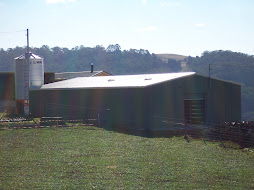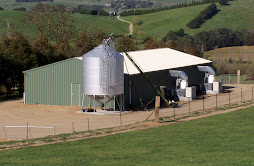Vanessa Burrow
November 8, 2006 The Age, Melbourne Australia
"IT'S like a paddock in a can, really," Glenda Wootton says, describing her hydroponic fodder
system.
The Tasmanian farmer runs about 200 head of cattle on 48.6 hectares and supplements their
feed with up to a tonne of barley shoots a day. The shoots are grown in a 100-square-metre
insulated and air-conditioned shed equipped with a hydroponics system.
In total, her hydroponics package has a $150,000 price tag but Ms Wootton is quick to defend
the investment.
"It's like a couple of extra hundred acres," she says. "It's not that much (money) when you
consider how much you would pay for a quality piece of land."
The inventor of the Commercial Hydroponic Fodder System, Peter Doyle, is convinced of the
value of his product, which starts at $130,000, particularly since the onset of drought across
Australia. About 1.2 tonnes of green feed a day can be produced for just 3¢ a kilo, using 500
litres of water, he says.
Inside a steel shed, seed is germinated and the shoots are fed intermittently with a thin film of
water and nutrient mix that recirculates through stacked PVC trays. A pump and sterilisation
system ensure the water nutrient mix remains fresh and disease-free.
Mr Doyle says it is a misconception that growing plants hydroponically requires more water
than conventional farming. Hydroponic growers who recirculate their water actually make
huge water savings, he says.
"There's not a paddock in the world that can produce 1250 kilograms a day on 500 litres of
water," Mr Doyle says.
The Commercial Hydroponic Fodder System and Mr Doyle's associated businesses, Corinella
Herbs and Glen Forbes Hydroponics, have already attracted attention from overseas,
including from the Netherlands, the US, the Middle East and the South Pacific.
But the fierce hydroponics advocate has not been able to interest the Australian Government
in his methods, or attract funding for research into the benefits and drawbacks of hydroponic
fodder.
"If our system is proven, hydroponic fodder systems will be an integral part of any farm
holding livestock," Mr Doyle says.
A report by Roger Sneath and Felicity McIntosh, of the Queensland Department of Primary
Industries and Fisheries, found cereal sprouts to be nutritious, though expensive to produce.
"It is essential to do your sums carefully," the report says. "To be profitable, sprouts would
need to provide consistent, exceptional performance with high-value outputs at minimal cost."
However, the report cites several references from the 1960s and Mr Doyle says new research
would be valuable. Colorado State University, the University of Wageningen in the
Netherlands and Sandia National Laboratories in the US have agreed to research elements of
the hydroponic fodder system.
Friday, 22 January 2010
Subscribe to:
Post Comments (Atom)





No comments:
Post a Comment